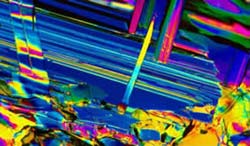Study Gives Lowdown On High-Temperature Superconductivity

Microscopic image of a ceramic superconductor <br>Image: Michael W. Davidson <br>Florida State University
A new study by theoretical physicists at the University of Toronto and the University of California at Los Angeles (ULCA) could bring scientists one step closer to the dream of a superconductor that functions at room temperature, rather than the frigid temperatures more commonly found in deep space.
The findings, which appear in the March 4 issue of the journal Nature, identify three factors that explain a perplexing pattern in the temperatures at which multi-layered ceramic materials become superconductors. The study could advance research in medical imaging, electrical power transmission and magnetically levitating trains. Its authors are U of T physics professor Hae-Young Kee and post-doctoral fellow Klaus Völker, and Professor Sudip Chakravarty of UCLA’s physics and astronomy department.
Superconductivity is a phenomenon that occurs when certain metals are cooled to near absolute zero, a temperature equivalent to zero degrees Kelvin (K), -273 C or -459 F. In ceramic materials, the phenomenon appears at about 100K. At a so-called critical temperature—that varies depending on the number of layers within the ceramic substance—the material becomes capable of conducting electricity without any energy loss.
Despite the value of such an efficient system, the supercooling—usually done with liquid nitrogen or liquid helium—makes superconductors impractical for many applications. “A room temperature superconductor would be a revolution, but even a superconductor with a higher critical temperature would have extremely important implications for multiple industries,” says Kee, who holds the Canada Research Chair in Theoretical Condensed Matter Physics.
Materials scientists have developed a group of “high-temperature” superconductors made with layers of copper oxides sandwiched between insulating filler material. This material reaches critical temperatures in the range of roughly 130K—the highest know critical temperatures to date. Previous studies on superconductors have established that while the critical temperature rises as the number of layers increase from one to three, it then drops off. By the time the number of layers rises to seven, the critical temperature has fallen below that of the single-layer superconductor.
Scientists have previously suggested that the critical temperature increase between one- and three-layered materials is due to the ability of electron pairs to tunnel between the layers of superconducting material.
Now, Kee and her colleagues have identified the factors that combine with a mechanism—known as the competing order—that lowers a superconductor’s critical temperature in materials with more than three layers. That “competing order,” in turn, is dependent on an uneven distribution of electrons, resulting in a charge imbalance between the material’s multiple layers. Kee and her colleagues are the first group to put these three factors—the tunnelling, the competing order and the charge imbalance—together.
“If we can find a way to affect the charge imbalance, we could suppress the competing order and develop superconducting materials with higher and higher critical temperatures,” says Kee. “And if you can push the superconducting temperature higher, then it will become much cheaper to apply this technology.”
The research was funded by the U.S. National Science Foundation, the Natural Sciences and Engineering Research Council of Canada, the Canadian Institute of Advanced Research, the Canada Research Chairs program and the Alfred P. Sloan Foundation.
CONTACT:
Klaus Völker
Department of Physics
416-333-5633 (cell)
voelker@physics.utoronto.ca
Hae-Young Kee (available March 4)
Department of Physics
416-978-5196
hykee@physics.utoronto.ca
Nicolle Wahl
U of T Public Affairs
416-978-6974
nicolle.wahl@utoronto.ca
Media Contact
All latest news from the category: Physics and Astronomy
This area deals with the fundamental laws and building blocks of nature and how they interact, the properties and the behavior of matter, and research into space and time and their structures.
innovations-report provides in-depth reports and articles on subjects such as astrophysics, laser technologies, nuclear, quantum, particle and solid-state physics, nanotechnologies, planetary research and findings (Mars, Venus) and developments related to the Hubble Telescope.
Newest articles

Superradiant atoms could push the boundaries of how precisely time can be measured
Superradiant atoms can help us measure time more precisely than ever. In a new study, researchers from the University of Copenhagen present a new method for measuring the time interval,…

Ion thermoelectric conversion devices for near room temperature
The electrode sheet of the thermoelectric device consists of ionic hydrogel, which is sandwiched between the electrodes to form, and the Prussian blue on the electrode undergoes a redox reaction…

Zap Energy achieves 37-million-degree temperatures in a compact device
New publication reports record electron temperatures for a small-scale, sheared-flow-stabilized Z-pinch fusion device. In the nine decades since humans first produced fusion reactions, only a few fusion technologies have demonstrated…





















